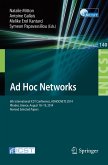Overview and Goals Wireless communication technologies are undergoing rapid advancements. The past few years have experienced a steep growth in research in the area of wireless ad hoc networks. The attractiveness of ad hoc networks, in general, is attributed to their characteristics/features such as ability for infrastructure-less setup, minimal or no reliance on network planning and the ability of the nodes to self-organize and self-configure without the involvement of a centralized n- work manager, router, access point or a switch. These features help to set up a network fast in situations where there is no existing network setup or in times when setting up a fixed infrastructure network is considered infeasible, for example, in times of emergency or during relief operations. Even though ad hoc networks have emerged to be attractive and they hold great promises for our future, there are several challenges that need to be addressed. Some of the well-known challenges are attributed toissues relating to scalability, quality-of-service, energy efficiency and security.
From the reviews: "This book delivers a useful addition to the already rich body of knowledge on wireless ad hoc networks. ... targets mainly the student community. ... Sections on future research and 'thoughts for practitioners' provided in each chapter make the book an interesting read for those who work in the research community, as well. ... the editor's have tackled the breadth versus depth dilemma in a balanced manner, making this book a useful reference for students, instructors, and practitioners alike." (Alessandro Berni, ACM Computing Reviews, December, 2009)








